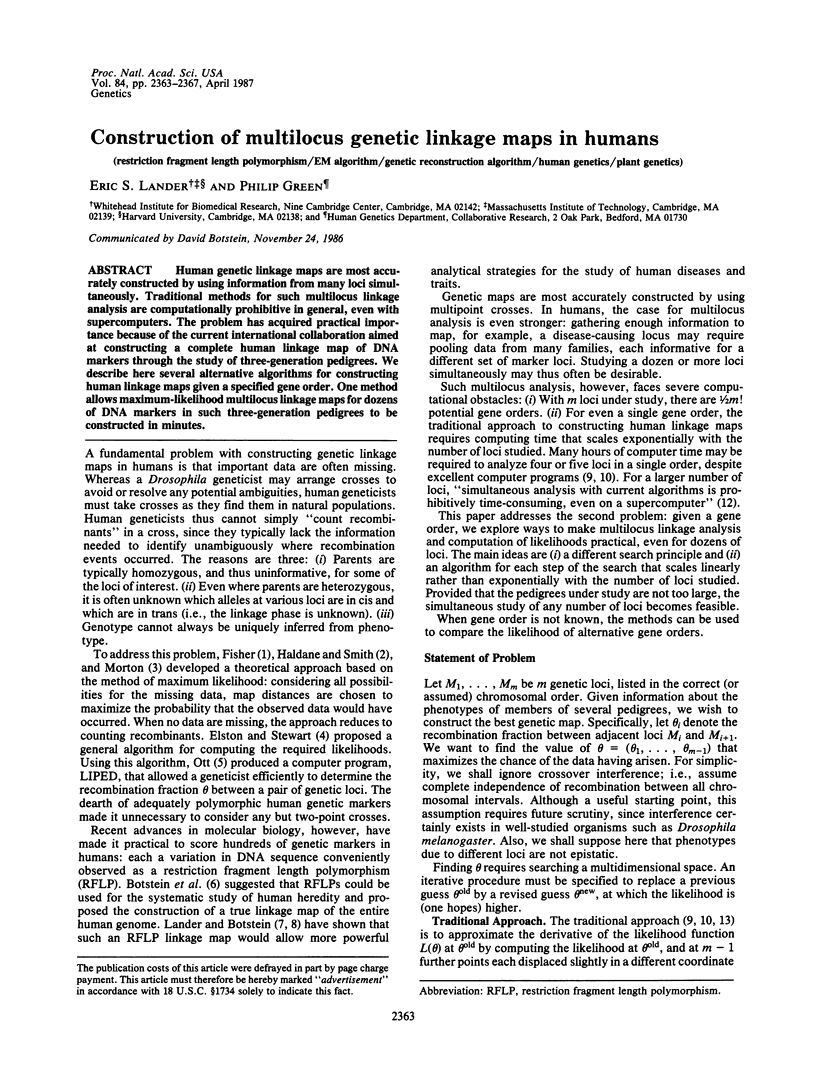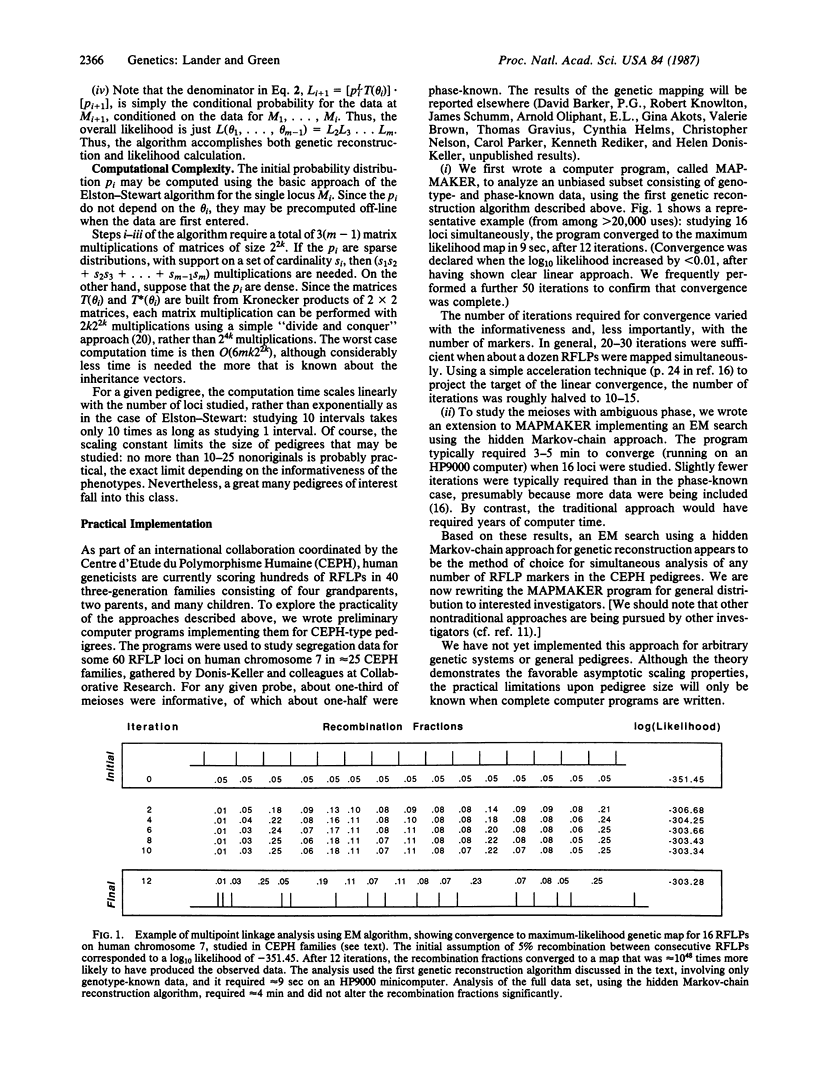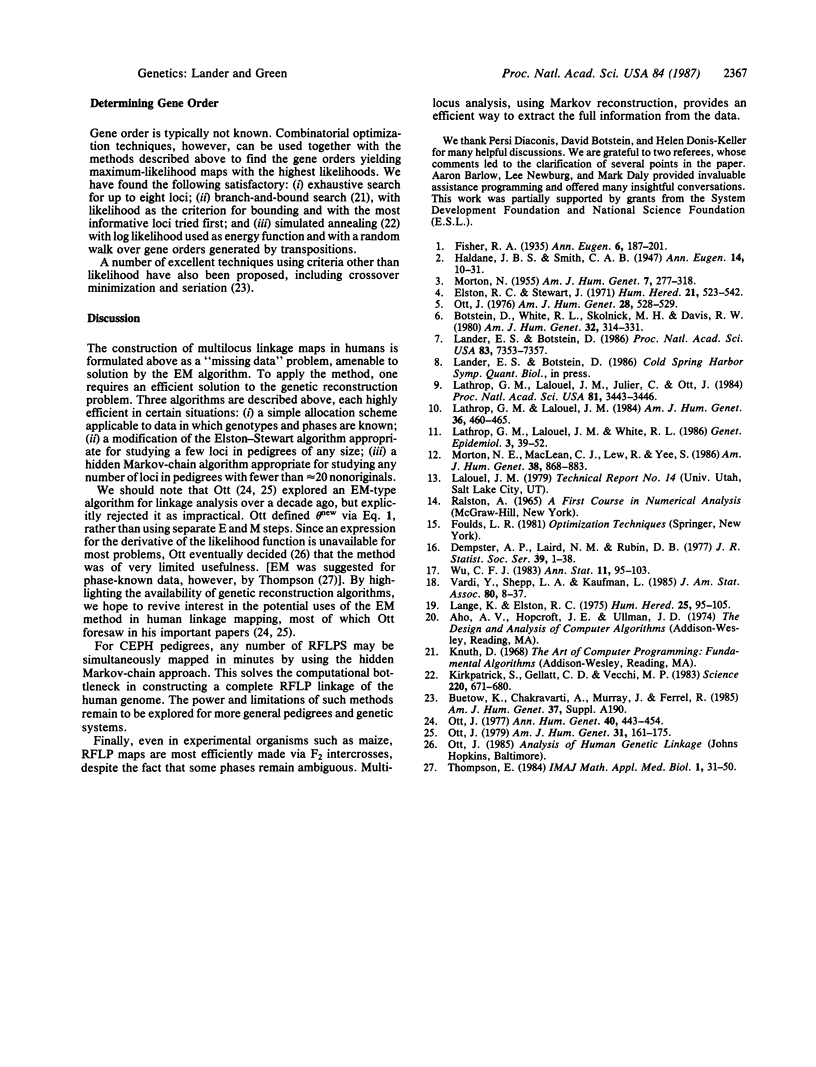Abstract
Human genetic linkage maps are most accurately constructed by using information from many loci simultaneously. Traditional methods for such multilocus linkage analysis are computationally prohibitive in general, even with supercomputers. The problem has acquired practical importance because of the current international collaboration aimed at constructing a complete human linkage map of DNA markers through the study of three-generation pedigrees. We describe here several alternative algorithms for constructing human linkage maps given a specified gene order. One method allows maximum-likelihood multilocus linkage maps for dozens of DNA markers in such three-generation pedigrees to be constructed in minutes.
Full text
PDF




Selected References
These references are in PubMed. This may not be the complete list of references from this article.
- Botstein D., White R. L., Skolnick M., Davis R. W. Construction of a genetic linkage map in man using restriction fragment length polymorphisms. Am J Hum Genet. 1980 May;32(3):314–331. [PMC free article] [PubMed] [Google Scholar]
- Elston R. C., Stewart J. A general model for the genetic analysis of pedigree data. Hum Hered. 1971;21(6):523–542. doi: 10.1159/000152448. [DOI] [PubMed] [Google Scholar]
- Kirkpatrick S., Gelatt C. D., Jr, Vecchi M. P. Optimization by simulated annealing. Science. 1983 May 13;220(4598):671–680. doi: 10.1126/science.220.4598.671. [DOI] [PubMed] [Google Scholar]
- Lander E. S., Botstein D. Strategies for studying heterogeneous genetic traits in humans by using a linkage map of restriction fragment length polymorphisms. Proc Natl Acad Sci U S A. 1986 Oct;83(19):7353–7357. doi: 10.1073/pnas.83.19.7353. [DOI] [PMC free article] [PubMed] [Google Scholar]
- Lange K., Elston R. C. Extensions to pedigree analysis I. Likehood calculations for simple and complex pedigrees. Hum Hered. 1975;25(2):95–105. doi: 10.1159/000152714. [DOI] [PubMed] [Google Scholar]
- Lathrop G. M., Lalouel J. M. Easy calculations of lod scores and genetic risks on small computers. Am J Hum Genet. 1984 Mar;36(2):460–465. [PMC free article] [PubMed] [Google Scholar]
- Lathrop G. M., Lalouel J. M., Julier C., Ott J. Strategies for multilocus linkage analysis in humans. Proc Natl Acad Sci U S A. 1984 Jun;81(11):3443–3446. doi: 10.1073/pnas.81.11.3443. [DOI] [PMC free article] [PubMed] [Google Scholar]
- Lathrop G. M., Lalouel J. M., White R. L. Construction of human linkage maps: likelihood calculations for multilocus linkage analysis. Genet Epidemiol. 1986;3(1):39–52. doi: 10.1002/gepi.1370030105. [DOI] [PubMed] [Google Scholar]
- MORTON N. E. Sequential tests for the detection of linkage. Am J Hum Genet. 1955 Sep;7(3):277–318. [PMC free article] [PubMed] [Google Scholar]
- Morton N. E., MacLean C. J., Lew R., Yee S. Multipoint linkage analysis. Am J Hum Genet. 1986 Jun;38(6):868–883. [PMC free article] [PubMed] [Google Scholar]
- Ott J. A computer program for linkage analysis of general human pedigrees. Am J Hum Genet. 1976 Sep;28(5):528–529. [PMC free article] [PubMed] [Google Scholar]
- Ott J. Counting methods (EM algorithm) in human pedigree analysis: linkage and segregation analysis. Ann Hum Genet. 1977 May;40(4):443–454. [PubMed] [Google Scholar]
- Ott J. Maximum likelihood estimation by counting methods under polygenic and mixed models in human pedigrees. Am J Hum Genet. 1979 Mar;31(2):161–175. [PMC free article] [PubMed] [Google Scholar]
- Thompson E. A. Information gain in joint linkage analysis. IMA J Math Appl Med Biol. 1984;1(1):31–49. doi: 10.1093/imammb/1.1.31. [DOI] [PubMed] [Google Scholar]


